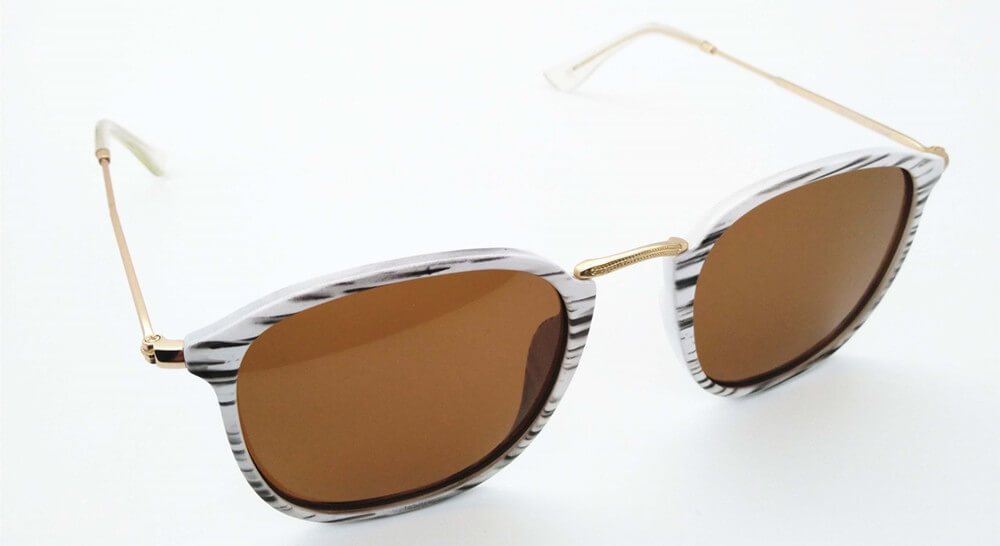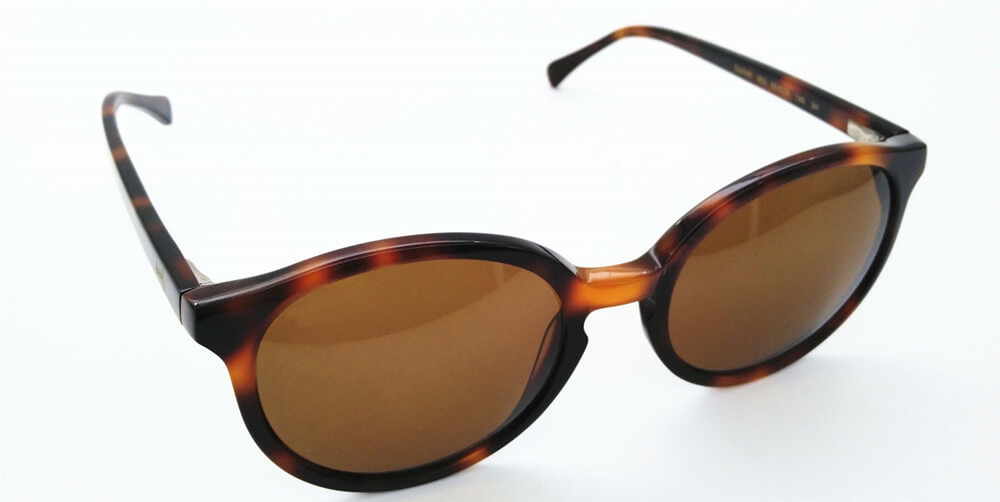When wearing sunglasses frames, many people find that some sunglasses will cause dizzy after wearing them, and in severe cases will have nausea or vomiting.
They might say. There are not having degree of sunglasses lenses. Why do you feel dizzy?
Sure, there is a type of sunglasses have degrees that are used for myopia, but here we mainly talk about the sunglasses lenses without degrees. Let’s take a look at what aspects will affect dizziness when we wear sunglasses.
1. Color of lenses:
Wearing sunglasses with too dark lenses (too low visible light transmittance) in daily environments (such as indoors) for a long time can cause visual fatigue and severe symptoms such as dizziness and nausea.
Some people wear sunglasses regardless of time and occasion, whether outdoors or indoors, regardless of the intensity of the sun, and even at dusk, evening, and when watching movies and TV. Doing this will increase the burden on the eyes. It will cause tension in the eye muscles, blurred vision, and in severe cases, symptoms such as dizziness, dizziness, and inability to see for a long time, and visual fatigue.
There are also people who feel uncomfortable naturally when wearing sunglasses lenses with progressively stained.
2. The frames of sunglasses:
For example, if the temples are worn too tightly, they will oppress the temples and cause dizziness. For dizziness caused by this situation, we only need to loosen the screws which are at the junction of the temples and the frame.
Or it may be the pressure caused by the nose pad which are parts of the sunglasses frames. No matter it is a metal nose pad or plastic nose pad. or the sphericity, prism, and other parameters of the lens itself are not equal.
3. Lens processing problems:
Sunglass lenses have no luminosity (except for myopic sunglasses), but if the size of the lens is too large during processing, and the lenses are forced into the frames, the optical index of the lens will exceed the standard under the stress of such long-term distortion. Wearing such sunglasses lenses can cause dizziness from light to light, and affect vision in severe cases.
The lens curvature is too large. The human eye’s cornea has a certain curvature, and the lens of sunglasses also has a certain curvature. When the curvatures of the two are parallel or relatively close, no extra light will be produced. This situation will not cause dizziness. But when the lens of the sunglasses is too large, it will cause extra diopter when worn glasses, which will cause the symptoms of dizziness. Therefore, it is best not to choose sunglasses with too large lens curvature.
4. Wrong wearing method:
Sunglasses can provide shade. After the people wear sunglasses, the amount of light penetration will be reduced, and the pupils will naturally expand. If you wear sunglasses in a place with insufficient light, it will increase the adjustment of the eyes, and the eyes will be easily fatigued. Wearing it for a long time will increase eye fatigue and the human body will feel dizzy. Therefore, it is best to remove the sunglasses indoors or in a cool place, and not to wear sunglasses for too long, which can relieve dizziness.
5. Unqualified lenses:
If the lens of sunglasses is unqualified, the diopter may exceed the standard, or the surface of the lens is not smooth, or even bubbles, etc., when the eyes look at external objects, they will be distorted and deformed, causing the eyeballs to sore and cause dizziness, nausea, decreased appetite, forgetfulness, insomnia and other symptoms of visual fatigue. Therefore, in order to prevent dizziness, it is best to go to professional optical shops and regular shops to buy sunglasses.
In fact, lenses are divided into many kinds of materials, and each lens material has its own advantages and disadvantages
For example, although glass lenses are wear-resistant and have better optical properties, their use is gradually reduced because they are heavy.
The resin lens (such as CR39 material) is easy to color, light, and impact-resistant, and has become one of the mainstream materials for fashion sunglasses; but the resin lens is easy to collapse during the edge cutting process, and it will still break when encountering huge impact.
PC lenses are better than resin lenses. They are characterized by lightness, good coloring performance, and stronger impact resistance. The disadvantage is low wear resistance.
TAC sunglasses lenses are widely used in the world. TAC (TriacetylCellulose) is one of the polymer materials with good light transmittance. As a sunglasses lens, TAC has the characteristics of acid and alkali resistance, lightweight, and high-cost performance, but its poor wear resistance has become the weakness of TAC lenses.
Nylon sunglasses lenses are used in the production of sports sunglasses. They have high elasticity, excellent optical quality, strong impact resistance, and professional protective functions; but the production cost is high.
In addition, the functional problems of the lens can also cause the problems: as follows
- Sunglass lenses with anti-ultraviolet function. Good sunglasses lenses can block more than 99% of ultraviolet rays, while lenses marked with UV400 can block 100% (99.99%) of ultraviolet rays. Wearing sunglasses with poor anti-ultraviolet function makes the eyes look like looking at objects in a dark room. At this time, the pupils will become larger, and the residual ultraviolet rays will be injected into the eyes in large quantities, causing damage to the eyes.
- Sunglass lenses with unqualified transmittance. After wearing this kind of sunglasses, it will cause traffic signal identification obstacles, which can easily cause traffic accidents. All sunglasses, including professional driving glasses, sports glasses, fishing glasses… (except for near-sighted glasses and reading glasses) The easy way to identify is to place the sunglasses in front of your eyes and observe distant objects through the lens, such as window frames or door frames Wait, then move the glasses up and down back and forth, the target should not swing and wavy deformation。
- Sunglass lenses without category identification. Sunglasses are generally divided into three categories, namely, sun-shading mirrors for sun protection, light-colored mirrors for decoration, and special mirrors for preventing snow blindness or water-proof plane radiation. Without product category identification, consumers cannot correctly identify the purpose of sunglasses when buying, which will affect the effect of use.
- Sunglass lenses whose performance does not meet the requirements. The lens is easily broken when impacted by an external force, and the fragments can cause fatal damage to human eyes. The material of the frame is also very important. Generally, there are plates, aluminum-magnesium alloys, and pure titanium. Different needs have different requirements for the sun. There are polarized sports mirrors, polarized driving mirrors, and polarized fishing glasses that are specially used for sports. When buying, you can ask about the professional use of sunglasses.
6. Be cautious when wearing large-frame sunglasses:
Nowadays, many fashionable young people prefer to wear large-frame sunglasses with wide sides, thick frames, and heavyweight. In fact, after wearing these glasses for 1 to 2 weeks, wearers will experience numbness in the eye sockets or two side cheeks. Symptoms such as insensitivity and nasal discomfort when breathing, like a cold. Others felt like insects crawling on their faces, numb gums in the upper jaw, uncomfortable upper incisors, and sore eyes. This is because the human facial sensation is mainly innervated by the trigeminal nerve, and the infraorbital branch of the trigeminal nerve passes through the inferior orbital rim
7. Others:
If dizziness is caused by wearing sunglasses for too long, you can control the time you wear sunglasses every day, preferably within 8 hours. Or if dizziness is caused by wearing sunglasses for the first time, try wearing them for a few days to relieve the situation.
The following people should pay special attention when using sunglasses:
1. Glaucoma patients: After wearing sunglasses, the visible light entering the eyes will decrease, and the pupils will naturally dilate, resulting in narrowing of the anterior chamber angle, resulting in poor drainage of aqueous humor. This change in pupils has no effect on healthy people, but it is for glaucoma patients, In other words, it is easy to induce acute attacks of glaucoma, with symptoms such as red jelly, eye pain, headache, nausea, vomiting, and the sharp decline in vision. Therefore, it is not recommended to wear sunglasses for patients with glaucoma or suspected glaucoma
2. Colorblind patients: Wearing sunglasses for people with full colorblindness has little effect. However, some color-blind patients lack the ability to distinguish only a few colors, and they are even more unable to distinguish colors after wearing sunglasses. There are also people with night blindness, optic nerve amenities, and other people who are not suitable for wearing sunglasses.
3. Children under 6 years old should not wear sunglasses. The visual function of children under 6 years of age is not yet mature, and wearing sunglasses for a long time will not be able to effectively stimulate the macular area of the fundus, which will affect the further development of vision and even form amblyopia.


